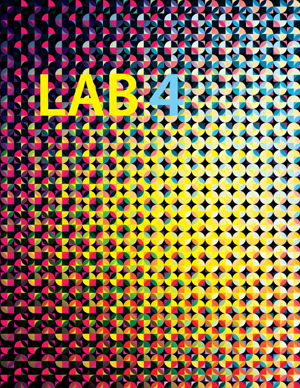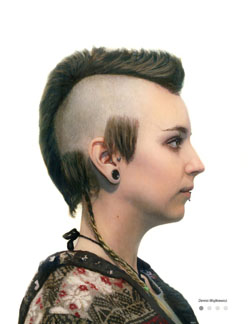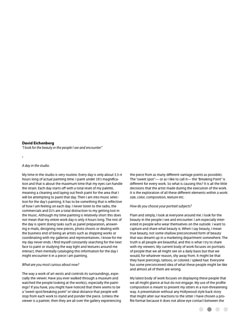David Eichenberg
“The truth is all people are beautiful.”
•
A day in the studio.
My time in the studio is very routine. Every day is only about 3.5–4 hours long of actual painting time. I paint under 3X’s magnification and that is about the maximum time that my eyes can handle the strain. Each day starts off with a total reset of my palette, meaning a cleaning and laying out fresh paint for the area that I will be attempting to paint that day. Then I am into music selection for the day’s painting. It has to be something that is reflective of how I am feeling on each day. I never listen to the radio, the commercials and DJ’s are a total distraction to my getting lost in the music. Although my time painting is relatively short this does not mean that my entire work day is only 4 hours long. The rest of the day is spent doing tasks such as panel preparation, answering e-mails, designing new pieces, photo shoots or dealing with the business end of being an artists such as shipping works or coordinating with my galleries and representatives. I know for me my day never ends. I find myself constantly searching for the next face to paint or studying the way light and textures around me interact, then mentally cataloging this information for the day I might encounter it in a piece I am painting.
What are you most curious about now?
The way a work of art exists and controls its surroundings, especially the viewer. Have you ever walked through a museum and watched the people looking at the work(s), especially the paintings? If you have, you might have noticed that there seems to be a “sweet spot/breaking point” or ideal distance that people will stop from each work to stand and ponder the piece. (Unless the viewer is a painter, then they are all over the gallery experiencing the piece from as many different vantage points as possible). The “sweet spot”— or as I like to call it— the “Breaking Point” is different for every work. So what is causing this? It is all the little decisions that the artist made during the execution of the work. It is the exploration of all these different elements within a work: size, color, composition, texture etc.
How do you choose your portrait subjects?
Plain and simply, I look at everyone around me. I look for the beauty in the people I see and encounter. I am especially interested in people who wear themselves on the outside. I want to capture and share what beauty is. When I say beauty, I mean true beauty, not some shallow preconceived form of beauty that was dreamt up in a marketing department somewhere. The truth is all people are beautiful, and this is what I try to share with my viewers. My current body of work focuses on portraits of people that we all might see on a daily basis but that we would, for whatever reason, shy away from. It might be that they have piercings, tattoos, or colored / spiked hair. Everyone has some preconceived idea of what these people might be like and almost all of them are wrong.
My latest body of work focuses on displaying these people that we all might glance at but do not engage. My use of the profile composition is meant to present my sitters in a non-threatening way. A presentation without any Hollywood style back story that might alter our reactions to the sitter. I have chosen a profile format because it does not allow eye contact between the viewer and the sitter.
I view these portraits almost like the old Audubon prints. They are a tool and way for people to study the world around them, within their own comfort zones and at their leisure without having to engage the subjects directly. In doing so, I hope their experiences and perceptions will be changed in the real world, when they encounter people displaying similar adornment.
Appearances are revealing and deceiving. Reminds me of some of the short pieces in Lawrence Weschler’s A Wanderer in the Perfect City. Part of portraiture challenges us to look deeper than surfaces. Or understand how surfaces reveal, hide, or influence interior landscapes (and vice versa).
Besides commision work, all of my sitters to date have been artists, either visual or performing. Let me clarify what I mean by “they wear themselves on the outside.” The people I have painted to date are not putting on a facade or hiding someone else inside. When I set up a photo shoot with my models, I never dictate what they wear. I do not alter their appearance in any way. The farthest I go when it comes to guidance with them is to tell them to wear what they normally would wear. The only thing that I adjust during the shoot is the positioning and lighting.
It sounds like you’re looking to capture a certain kind of verisimilitude. Have you seen Joy McKinney’s work? She approaches strangers on the street and asks to take a picture of her hand touching each person’s face.
I absolutely love it. I totally respect that she can even approach people with such a request. When starting out, it was always difficult to ask strangers if they would let me paint them, let alone asking a stranger to let me touch their face while photographing them. The beauty of her pieces is the realness and instant connection she can achieve with the person being photographed.
Your oil painting portraits almost look like photo portraits. Do you use photography in your process?
I do use photo references for my work. Most of my reference shots are simple quick snapshots. I know within the art world there is a lot of resistance, among painters, to the use of photography. Photography to me is simply a tool which allows me to record relevant information quickly, without having to burden my models /sitters with having to sit for hours. Since it can take up to 4 weeks to finish a 4” x 6” piece, photographing my subjects is the only viable option.
Mona Lisa’s smile.
I am not convinced that she is actually smiling. The Mona Lisa seems to change before our eyes during viewing. Every time I see this piece I can not help but feel that I have been given just enough information to keep my understanding of the piece in flux. •



